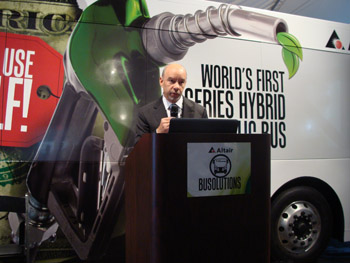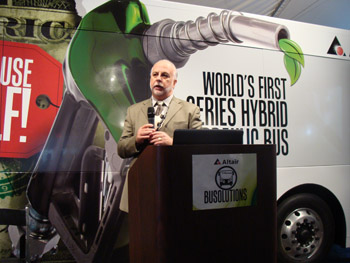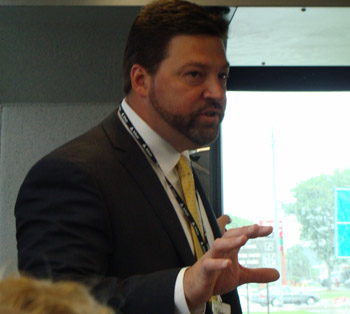 Normally, the figure of 6.9 mpg wouldn’t get many people’s hearts racing. But this number, achieved by Altair ProductDesign’s new BUSolutions prototype, is fairly stunning. Doing real-world testing of the LCO-140H bus over downtown, commuter and arterial routes, the bus achieved a 6.9 mpg average. Compare that with 3.3 mpg for a same-class diesel bus going through the identical testing, and the number begins to impress.
Normally, the figure of 6.9 mpg wouldn’t get many people’s hearts racing. But this number, achieved by Altair ProductDesign’s new BUSolutions prototype, is fairly stunning. Doing real-world testing of the LCO-140H bus over downtown, commuter and arterial routes, the bus achieved a 6.9 mpg average. Compare that with 3.3 mpg for a same-class diesel bus going through the identical testing, and the number begins to impress.
Design engineers on the BUSolutions team took a clean-sheet approach to design the bus, using Altair’s HyperWorks computer-aided engineering software suite, according to Mike Heskitt, COO. The Federal Transit Administration (FTA) has provided $5.1 million of funding towards the program with additional program support provided by the Michigan Economic Development Corporation (MEDC) and Automation Alley.
The rollout in September at the Altair world headquarters in Troy, Michigan, was an impressive one. A steady rain from the leftovers of Tropical Storm Lee couldn’t dampen the mood as Altair founder and CEO Jim Scapa (photo above) spoke, the bus pulling in behind the speaker dias in dramatic fashion.
Heskett said that with hybrids, “You really have to pick the right technology. One answer is not the same for every vehicle.”
A series hybrid system was chosen because of the high power density, according to Heskett. The bus can return 70% of the power captured from braking back to the wheels during subsequent acceleration. He also said that the fact that these series systems have lower lifetime costs and are proven technology factored into the design decision.
“It became very clear that Parker Hannifin was in the best place to support us,” Heskitt said. “They had experience in refuse vehicles.”
Parker’s Vince Zanardelli, business unit manager, energy recovery, told Design World that the company’s initiative with refuse trucks in Florida has been going extremely well, with a 45% fuel savings thus far.
“But we’ve had our first complaints,” Zanardelli said. “Customers are saying the system is too quiet.”
It seems that residents are used to hearing the garbage trucks coming from a block or two away, and tend to drag out their trash at the last moment. With the Parker series hydraulic hybrid systems installed, they oftentimes never hear the trucks—then call to complain that the trucks never came down their street (when, in fact, they had).
Such is the price of modern technology.
Find more videos like this on The Engineering Exchange
Find more videos like this on The Engineering Exchange
Altair ProductDesign
BUSolutions
Parker Hannifin Corp.





I have thought for a while that a hybrid garbage truck would be a good thing. All that energy thrown away in stopping every 100 feet is partially recovered. Can we expect lower maintenance costs for brakes and drive hardware? This should be a real benefit for city bus services.
Interesting that they they are quite enough that they aren’t heard in the neighborhood, I have at time sprung out of bed and made the mad dash to drag the garbage and recycling barrels out to the curb.
Would this technology be applicable/ cost effective in a motorhome?
And what if it could be adapted to run on electricity instead of diesel? It would be jjust a matter of removing the ICE and replacing it with an electric motor and it could do “opportunity” power tapping from overhead wires such as seen in the Siemens eHighway concept (no propulsion batteries need apply) :
http://www.mobility.siemens.com/mobility/global/en/interurban-mobility/road-soluti
ons/electric-powered-hgv-traffic-ehighway/the-ehighway-concept/pages/the-ehighway-concept.aspx